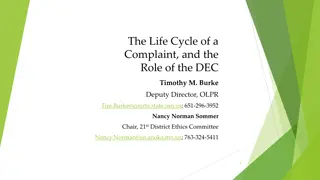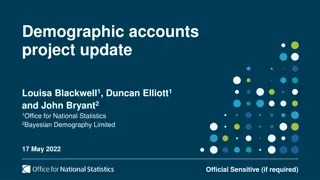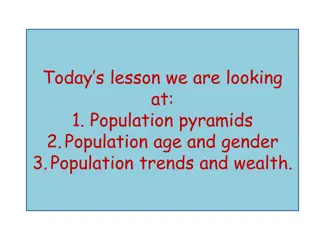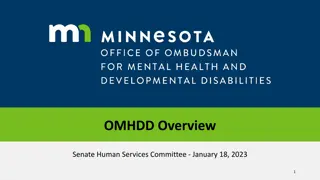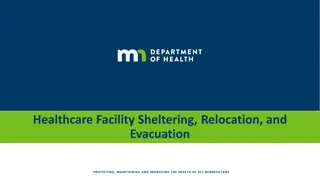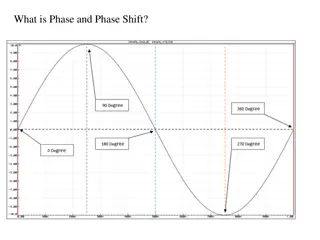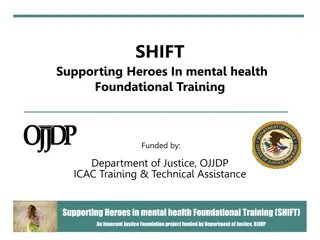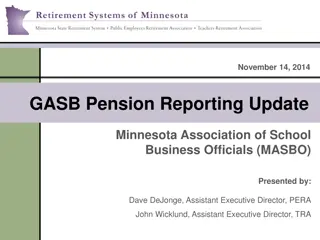Demographic Shift and Health Trends in Minnesota
Minnesota is facing a significant demographic shift with the aging population projected to increase, leading to an increased need for health and long-term care services. The longer life expectancy and retirement age highlights the importance of financial planning. Understanding the leading causes of premature death and behavioral risk factors can assist in setting community health priorities.
Download Presentation

Please find below an Image/Link to download the presentation.
The content on the website is provided AS IS for your information and personal use only. It may not be sold, licensed, or shared on other websites without obtaining consent from the author. Download presentation by click this link. If you encounter any issues during the download, it is possible that the publisher has removed the file from their server.
E N D
Presentation Transcript
TEMPLATE PRESENTATION This presentation will need to be tailored to your jurisdiction s context and needs. Data should reflect your local jurisdiction Pictures should reflect your community s demographics and features Notes have been added throughout this presentation, in places where local information might be best incorporated Feel free to remove slides that are not pertinent to your local conversation
A Snapshot Demographics and Health in [Jurisdiction Names]
Major Demographic Shift Between now and 2030, Minnesota will experience the most profound age shift in its history. The baby boomers 1.5 million strong in Minnesota will lead us into this uncharted territory as they begin to age. By 2030, we will have 1.2 million persons over 65, or one out of every four Minnesotans. Later, in 2050, we will have the largest number ever of people over 85. These elderly will need health and long term care. Source: Minnesota Dept. of Human Services, 2030 Project
Live Savings Need to Last Longer Average retirement age has gone down Average life expectancy has increased The length of retirement is getting longer Life savings need to stretch further
Leading Causes of Premature Death Date 100.0 Age-Adjusted Premature Death Rate 88.7 90.0 80.0 per 100,000 persons 70.0 60.0 50.0 38.0 40.0 24.8 30.0 20.0 12.2 10.0 1.0 1.0 1.0 1.0 1.0 1.0 1.0 1.0 1.0 1.0 1.0 1.0 1.0 1.0 1.0 1.0 0.0 Cancer Heart Disease Unintentional Injury CLRD County/Jurisdiction1 County/Jurisdiction2 County/Jurisdiction3 County/Jurisdiction4 Minnesota Source: Minnesota County Health Tables
Behavioral Risk Factors for Adults 2013 30% 26% 25% 20% 19% 20% 17% 15% 10% 5% 1% 1% 1% 1% 1% 1% 1% 1% 1% 1% 1% 1% 1% 1% 1% 1% 0% Physical Inactivity Obesity Smoking Excessive Drinking County/Jurisdiction1 County/Jurisdiction2 County/Jurisdiction3 County/Jurisdiction4 Minnesota Source: County Health Rankings
Community Health Priorities 2015 County/Jurisdiction 1 Issue 1 Issue 2 Issue 3 Issue 4 Issue 5 Issue 6 Issue 7 Issue 8 Issue 9 Issue 10 County/Jurisdiction 2 Issue 1 Issue 2 Issue 3 Issue 4 Issue 5 Issue 6 Issue 7 Issue 8 Issue 9 Issue 10 County/Jurisdiction 3 Issue 1 Issue 2 Issue 3 Issue 4 Issue 5 Issue 6 Issue 7 Issue 8 Issue 9 Issue 10 County/Jurisdiction 4 Issue 1 Issue 2 Issue 3 Issue 4 Issue 5 Issue 6 Issue 7 Issue 8 Issue 9 Issue 10
Students Eligible for Free/Reduced Meals 2005-present 45.0% % of Children in Jurisdiction Eligible to Receive Meals in October of Each Year 40.0% 35.0% 30.0% County/Jurisdiction1 25.0% County/Jurisdiction2 County/Jurisdiction3 20.0% County/Jurisdiction4 15.0% Minnesota 10.0% 5.0% 0.0% 2008 2009 2010 2011 2012 2013 2014 2015 Source: Minnesota KIDS COUNT
Children from Low-Income Homes are More Likely to Be in fair or poor health Lack access to quality health care Do less well in math and reading Be exposed to parental adversities Have higher rates of diagnosable disorders and learning problems As adults, they are at greater risk of remaining poverty Source: National Center for Children in Poverty
Children Receiving Special Education Services Date 30% 25% 25% 25% 25% 25% 20% 15% 10% 5% 0% County/Jurisdiction1 County/Jurisdiction2 County/Jurisdiction3 County/Jurisdiction4
Serious Emotional Disturbance Mental health concern; interferes significantly with a child s functioning at home and school In Minnesota, X percent of school- age children and X percent of preschool children have a serious emotional disturbance
Substance Abuse: Teens, Adolescents 2013 30% % of 11th Graders in Past 30 Days 25% 25% 25% 25% 25% 25% 25% 25% 25% 25% 25% 25% 25% 25% 25% 25% 25% 19% 20% 15% 10% 6% 6% 5% 5% 0% Tobacco use (past 30 days) Frequent tobacco use (20 of past 30 days) Frequent binge drinking (past year) Use of marijuana/ other drugs (past year) County/Jurisdiction1 County/Jurisdiction2 County/Jurisdiction3 County/Jurisdiction4 Minnesota Source: Minnesota Dept. of Health, Minnesota Student Survey
Sexual Activity: Teens, Adolescents 2013 40% 70% 65% 37% % of SexuallyActive 11th Graders 56% 60% 35% 50% 30% % of ALL 11th Graders 40% 25% 30% 20% 20% 10% 15% 1% 1% 1% 1% 1% 1% 1% 1% 0% 10% Condom use STD/AIDS awareness 5% County/Jurisdiction1 County/Jurisdiction2 1% 1% 1% 1% County/Jurisdiction3 County/Jurisdiction4 0% Minnesota Had sexual intercourse Source: Minnesota Dept. of Health, Minnesota Student Survey
Questions Are there other issues or things that might influence/impact this discussion and decision? What would you like more information on for the next meeting? What else has surfaced for you?
Thank You! [contact information]

















